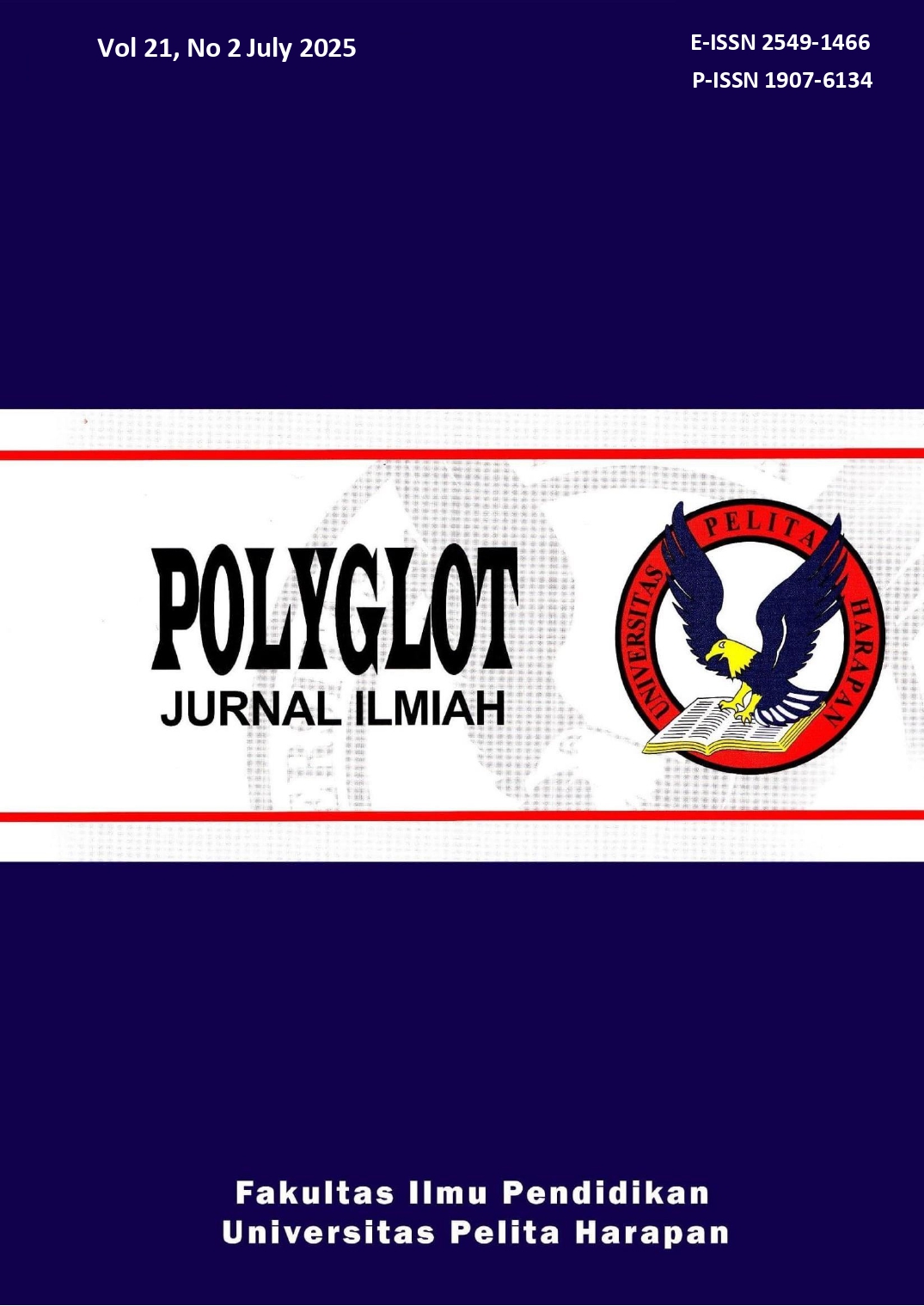ANALISIS PENGGUNAAN CAMPUR KODE MAHASISWA MELALUI PESAN WHATSAPP DAN SUREL SEBAGAI IMPLIKASI DARI XENOGLOSOFILIA [ANALYSIS ON STUDENTS' CODE-MIXING USAGE THROUGH WHATSAPP MESSAGE AND EMAIL AS AN IMPLICATION OF XENOGLOSSOPHILIA]
DOI:
https://doi.org/10.19166/pji.v21i2.10004Keywords:
Integration; psychology; Christianity; teaching strategy; higher education, Integrasi; psikologi; kekristenan; strategi mengajar; pendidikan tinggiAbstract
Language contact is one of the reasons for one's language variety or variation. The use of variation will also depend on the language attitude, whether it is included in a positive or negative language attitude toward a language. One of the languages in question is Indonesian, which is often mixed with words from foreign languages, especially English, thus violating the language codes of the variety used. This is known as code mixing. This study uses a survey method to find out the language attitudes of students at one of the private universities in Tangerang towards Indonesian and an observation method through the Simak Libat Cakap (SLC) technique to analyze the forms of student code-mixing. Based on the study's results, students still maintain a positive attitude towards the language, as evidenced by their pride in the Indonesian language. The findings of code mix used, such as the words text, quiz, error, submit, online class, upload, join, and others. Thus, from the results of the analysis of the forms of student code mix, it is evident that the phenomenon of xenoglossophilia occurs.
Abstrak Bahasa Indonesia
Kontak bahasa menjadi salah satu alasan terjadinya ragam atau variasi bahasa seseorang. Penggunaan variasi itu pun akan bergantung pada sikap berbahasanya apakah termasuk dalam sikap bahasa positif atau negatif pada suatu bahasa. Salah satu bahasa yang dimaksud adalah bahasa Indonesia yang kerap kali dicampuradukkan dengan kata-kata dari bahasa asing sehingga menyalahi kode-kode bahasa dari ragam yang digunakan. Hal inilah yang dikenal dengan istilah campur kode. Penelitian ini menggunakan metode survei untuk mengetahui sikap bahasa mahasiswa UPH terhadap bahasa Indonesia dan metode observasi melalui teknik Simak Libat Cakap (SLC) untuk menganalisis bentuk-bentuk campur kode mahasiswa UPH. Berdasarkan hasil penelitian, mahasiswa UPH tergolong memiliki sikap bahasa positif berupa sikap bangga terhadap bahasa Indonesia. Akan tetapi, dari hasil analisis bentuk-bentuk campur kode mahasiswa UPH, mengimplikasikan bahwa fenomena xenoglosofilia benar-benar terjadi.
References
Keraf, Gorys. (1997). Komposisi. Flores: Nusa Indah.
Kemendikbud. (2011). Undang-Undang Republik Indonesia Nomor 24
Tahun 2009 tentang Bendera, Bahasa, dan Lambang Negara,
serta Lagu Kebangsaan. Jakarta: Badan Pengembangan dan
Pembinaan Bahasa.
Kemendikbud. (2019). Perpres No. 63 Tahun 2019 tentang Penggunaan
Bahasa Indonesia. Diunduh
https://peraturan.bpk.go.id/Details/121661/perpres-no-63-tahun-2019. 17 Juni 2025.
Kepres No. 57 Tahun 1972 tentang Peresmian Berlakunya EYD. Diunduh dari https://id.wikisource.org/wiki/Berkas:Keputusan_Presiden_No._57_tahun_1972.pdf.
Kridalaksana, Harimurti. (2008). Kamus Linguistik Edisi Keempat.
Jakarta: Gramedia Pustaka.
Kahar, Siti Hardianti (dkk.). (2024). “Kontak Bahasa dan Perubahan
Dialektika: Tinjauan Sosiolinguistik di Wilayah Perbatasan
Kabupaten Pinrang dan Kota Parepare”.
Diunduh dari laman https://jurnal.umj.ac.id/index.php/penaliterasi/article/view/12964/pdf. 13 Mei 2025.
Lanin, Ivan. (2018). Xenoglosofilia: Kenapa Harus Ngingris?
Jakarta: Kompas Gramedia.
Mahsun. (2019). Metode Penelitian Bahasa: Tahapan, Strategi,
Metode, dan Tekniknya. Depok: PT Raja Grafindo Persada.
Permen No. 40 Tahun 2007 Pedoman bagi Kepala Daerah dalam
Pelestarian dan Pengembangan Bahasa Negara dan
Bahasa Daerah. Diunduh dari https://badanbahasa.kemdikbud.go.id/lamanbahasa/sites/default/files/PerMenDagri_No_40_2007.pdf. 15 Mei 2025.
Robert dan Karin Sternberg. (2012). Cognition, Sixth Edition, International
Edition. Canada: Wadsworth, Cenggage Learning.
Suryani, Azizah (dkk.). (2022). ”Kontak Bahasa Betawi dan Minangkabau
di Komunitas Mahasiswa Minangkabau di Ciputat”.
Diunduh dari laman https://jurnal.umj.ac.id/index.php/penaliterasi/article/view/12964/pdf. 13 Mei 2025.
Downloads
Published
Issue
Section
License
Copyright (c) 2025 Jonter Pandapotan Sitorus

This work is licensed under a Creative Commons Attribution-ShareAlike 4.0 International License.
Authors who publish with this journal agree to the following terms:
1) Authors retain copyright and grant the journal right of first publication with the work simultaneously licensed under a Creative Commons Attribution License (CC-BY-SA 4.0) that allows others to share the work with an acknowledgement of the work's authorship and initial publication in this journal.
2) Authors are able to enter into separate, additional contractual arrangements for the non-exclusive distribution of the journal's published version of the work (e.g., post it to an institutional repository or publish it in a book), with an acknowledgement of its initial publication in this journal.
3) Authors are permitted and encouraged to post their work online (e.g., in institutional repositories or on their website). The final published PDF should be used and bibliographic details that credit the publication in this journal should be included.





